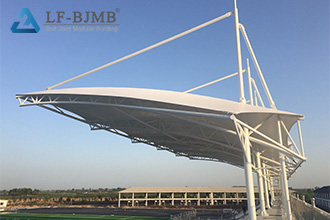When designing stadium bleachers, there are multiple considerations to take into account to ensure that they are safe, functional and meet various regulations. Here are some of the key considerations:

1.Structural Stability: Stadium stands must be structurally stable enough to withstand large numbers of people and various dynamic loads. The design needs to carefully analyze the various loads, both static and dynamic, as well as possible extremes, such as natural disasters like earthquakes and windstorms.
2.Visual field and seating layout: The design needs to take into account the view of the audience and the seating layout. It should be ensured that every spectator has a good view, while the seating layout should be reasonable so that spectators can watch the game comfortably. In addition, consideration should be given to spectators of different heights and visual acuity, including those with disabilities.
3.Safety exits and evacuation routes: The location and number of safety exits and evacuation routes should be taken into account in the design. These routes should be able to evacuate large numbers of people quickly and efficiently, while also considering how quickly the exits can be closed and blocked in an emergency.
4.Material selection: Choosing the right building materials is critical to the safety and durability of the stands. Factors such as the strength, durability and fire resistance of the material need to be taken into account.
5.Environmental protection and sustainability: The design needs to consider the use of environmentally friendly and sustainable materials and techniques. This includes the use of recyclable materials, energy-efficient technologies, etc., while also taking into account the need to minimize the impact on the environment.
6.Lighting and acoustic design: If the stands are equipped with lighting, the design of the lighting needs to be considered. It is important to ensure that the lighting does not interfere with the view of spectators, and also to consider the impact of nighttime lighting on the surrounding environment. Acoustic design is also important to ensure that sound does not disturb spectators during the game.
7.Budget and control: The design needs to take into account budget and control factors. Design solutions should meet budgetary requirements and also take into account possible future maintenance and repair costs.
8.Compliance and Permits: The design needs to be informed by local regulations and standards to ensure that the design solution meets all relevant codes and safety standards. Relevant permits or approvals may need to be obtained before construction can begin.
9.Long-term planning: The design needs to take into account the long-term planning for the grandstand, including possible future remodeling or expansion. This helps to ensure that the current facility will still be able to meet demand in the future.
10.Harmony with the surrounding environment: The design of the grandstand should be in harmony with the surrounding environment, including the rest of the stadium, surrounding buildings and landscaping.
These considerations are just some of the factors that need to be taken into account when designing a stadium grandstand. More factors need to be considered during the actual design process and may require assessment and advice from professional engineers and other experts.











 About Us
About Us 2024-01-12
2024-01-12


